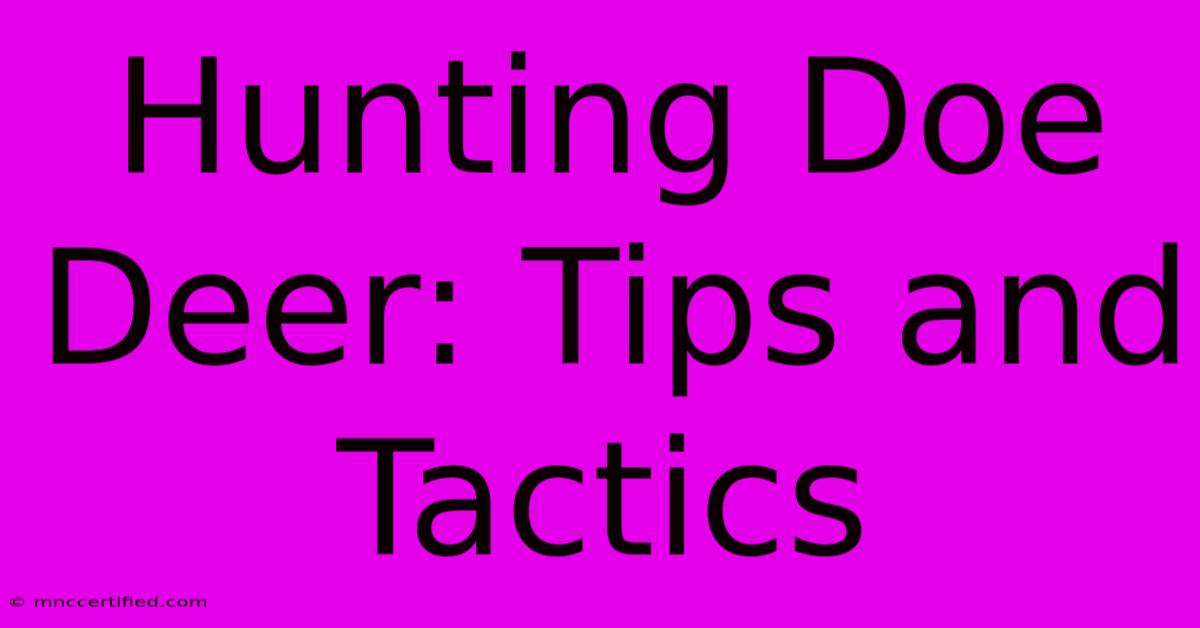Hunting Doe Deer: Tips And Tactics

Table of Contents
Hunting Doe Deer: Tips and Tactics for a Successful Hunt
Hunting doe deer presents unique challenges and rewards compared to hunting bucks. Understanding doe behavior, employing effective hunting strategies, and mastering the necessary skills are crucial for a successful hunt. This comprehensive guide will equip you with the knowledge and tactics to increase your chances of bagging a mature doe.
Understanding Doe Deer Behavior
Before we delve into tactics, understanding doe behavior is paramount. Unlike bucks, which are often more focused on territorial displays during the rut, does prioritize survival and the well-being of their fawns. This influences their movement patterns, feeding habits, and overall alertness.
Seasonal Variations:
- Spring: Does are focused on raising their fawns, often staying close to bedding areas with abundant cover. They are less likely to venture far from food and water sources. This makes ambush hunting near preferred feeding grounds particularly effective.
- Summer: Does are still protective of their fawns, but their movement range expands slightly as fawns grow more mobile. They'll utilize a wider variety of food sources.
- Fall: As the rut approaches, does become more active as bucks start to pursue them. However, their focus remains on food and security. This is a good time to utilize scent control and strategically placed stands near established trails.
- Winter: Does seek out areas with ample food and shelter from harsh weather. They will concentrate in areas with readily available browse, making them easier to locate, but also more cautious.
Feeding Habits:
Does are primarily browsers, consuming a variety of plants, leaves, and twigs. Understanding their preferred food sources in your hunting area is vital. Knowing where they feed allows you to strategically place your stand or blind to maximize your chances of a successful encounter.
Effective Hunting Tactics for Doe Deer
Choosing the right tactic depends largely on the time of year, the terrain, and your hunting style. Here are some proven methods:
1. Still Hunting:
Still hunting involves slowly and quietly moving through the woods, searching for deer. This is best suited for areas with thick cover where deer are more likely to be found. Patience and a keen eye are essential. Use the wind to your advantage, approaching from downwind to avoid alerting deer to your presence.
2. Stand Hunting:
Stand hunting is a highly effective method, especially during the early morning and late evening hours when deer are most active. Select a location near established trails, feeding areas, or water sources. Scent control is crucial for stand hunting. Use scent-eliminating sprays and clothing to mask your human scent.
3. Trail Camera Scouting:
Before heading out for a hunt, employing trail cameras is indispensable. They reveal deer activity patterns, providing crucial intel on preferred trails, feeding areas, and bedding locations. This allows for strategic stand placement and maximizes your hunting time.
4. Drive Hunting (with caution):
Drive hunting involves a group of hunters pushing deer towards other hunters in a designated area. This method requires careful planning and coordination to ensure safety and ethical hunting practices. It's generally more effective in larger areas with significant deer populations. Always prioritize safety and communication.
Essential Gear and Techniques
Success in hunting doe deer depends not just on tactics, but also on the quality of your gear and your mastery of essential techniques:
- High-Quality Rifle or Bow: Choose a weapon suitable for your hunting style and the hunting regulations in your area. Ensure accuracy and proper sighting are achieved through practice.
- Scent Control: Use scent-eliminating sprays, clothing, and detergents to mask your human odor, crucial for remaining undetected.
- Binoculars and Rangefinder: These tools are invaluable for spotting deer at a distance and determining accurate shot distances.
- Camouflage Clothing: Blend into your surroundings to avoid detection by deer.
- Proper Shot Placement: Accurately placing your shot is critical for a quick and humane kill. Practice your shooting skills extensively.
Ethical Considerations
Remember to always practice ethical hunting. This includes understanding hunting regulations, obtaining proper licenses and permits, ensuring safe firearm handling, and making ethical shot placements for a clean and quick harvest. Respecting wildlife and your hunting environment are paramount.
By understanding doe behavior, employing effective tactics, and using the right gear, you can significantly improve your chances of a successful doe deer hunt. Remember that patience, preparation, and a respect for the animal are crucial ingredients for a rewarding and ethical hunting experience.

Thank you for visiting our website wich cover about Hunting Doe Deer: Tips And Tactics. We hope the information provided has been useful to you. Feel free to contact us if you have any questions or need further assistance. See you next time and dont miss to bookmark.
Featured Posts
-
Trinity Real Estate Investments
Nov 26, 2024
-
Menendez Brothers Hearing Delayed To January
Nov 26, 2024
-
Hallmark Specialty Insurance Co
Nov 26, 2024
-
Get Lana Del Rey Uk Tour Tickets
Nov 26, 2024
-
Understanding Larry Cases Doe
Nov 26, 2024